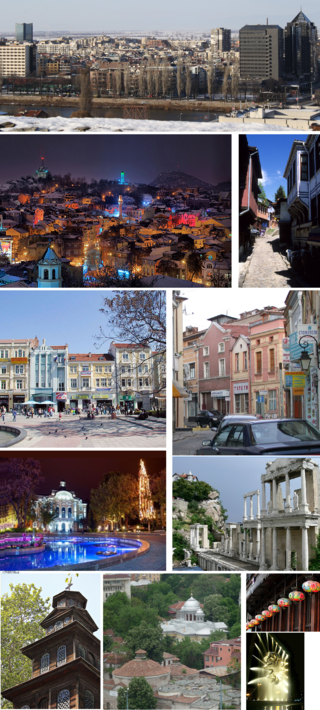
Plovdiv is the second-largest city in Bulgaria, standing on the banks of the Maritsa river in the historical region of Thrace, behind the state capital Sofia. It has a population of 346,893 as of 2018 and 675,000 in the greater metropolitan area. Plovdiv is a cultural hub in Bulgaria and was the European Capital of Culture in 2019. The city is an important economic, transport, cultural, and educational center. Plovdiv joined the UNESCO Global Network of Learning Cities in 2016.

Nesebar is an ancient city and one of the major seaside resorts on the Bulgarian Black Sea Coast, located in Burgas Province. It is the administrative centre of the homonymous Nesebar Municipality. Often referred to as the "Pearl of the Black Sea", Nesebar is a rich city-museum defined by more than three millennia of ever-changing history. The small city exists in two parts separated by a narrow human-made isthmus with the ancient part of the settlement on the peninsula, and the more modern section on the mainland side. The older part bears evidence of occupation by a variety of different civilisations over the course of its existence.
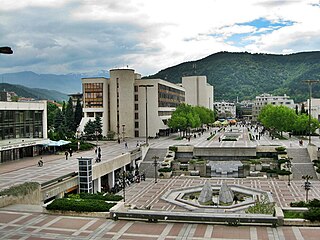
Blagoevgrad is а town in Southwestern Bulgaria, the administrative centre of Blagoevgrad Municipality and of Blagoevgrad Province. With a population of almost 70,000 inhabitants, it is the economic and cultural centre of Southwestern Bulgaria. It is located in the valley of the Struma River at the foot of the Rila Mountains, 101 kilometres south of Sofia, close to the border with North Macedonia.

Koprivshtitsa is a historic town in the Koprivshtitsa Municipality in Sofia Province, central Bulgaria, lying on the Topolnitsa River among the Sredna Gora mountains. It was one of the centres of the April uprising in 1876 and is known for its authentic Bulgarian architecture and for its folk music festivals, making it a tourist destination.
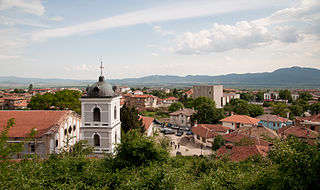
Sopot is a Bulgarian town situated in the fertile sub-Balkan mountain valley of Karlovo, immediately below the steep southern slopes of the Troyan Balkan Mountain. Sopot is part of Plovdiv Province and is the administrative centre of a municipality with the same name.

The Bulgarian Revival sometimes called the Bulgarian National Revival, was a period of socio-economic development and national integration among Bulgarian people under Ottoman rule. It is commonly accepted to have started with the historical book, Istoriya Slavyanobolgarskaya, written in 1762 by Paisius, a Bulgarian monk of the Hilandar monastery at Mount Athos, lead to the National awakening of Bulgaria and the modern Bulgarian nationalism, and lasted until the Liberation of Bulgaria in 1878 as a result of the Russo-Turkish War of 1877–1878.

Panagyurishte is a town in Pazardzhik Province, Southern Bulgaria, situated in a small valley in the Sredna Gora mountains. It is 91 km east of Sofia, 43 km north of Pazardzhik. The town is the administrative centre of the homonymous Panagyurishte Municipality. Panagyurishte is an important industrial and economic center. According to the 2021 census, it has a population of 15,275 inhabitants.

Karlovo is a historically important town in central Bulgaria located in a fertile valley along the river Stryama at the southern foot of the Balkan Mountains. It is administratively part of Plovdiv Province and has a population of about 25.091, the mayor being Dr. Emil Kabaivanov.

Pazardzhik is a city situated along the banks of the Maritsa river, southern Bulgaria. It is the centre of Pazardzhik Province and Pazardzhik Municipality. It is located in the Upper Thracian Plain and in the Pazardzhik-Plovdiv Field, a subregion of the plains. It is west of Plovdiv, about 37 kilometres (23 mi), 112 kilometres (70 mi) southeastern of Sofia and 288 kilometres (179 mi) from Burgas. The population is around 65,671, as it has been growing around from the end of the 19th century to the end of the 20th century. The city reached its highest milestone, exceeding 80,000. Due to poor economic performance in Bulgaria during the 1990s and early 2000s, emigration of Bulgarians began, which affected Pazardzhik as well.

Dupnitsa, or Dupnica, is a town in Western Bulgaria. It is at the foot of the highest mountains in the Balkan Peninsula – the Rila Mountains, and about 50 km (31 mi) south of the capital Sofia. Dupnitsa is the second largest town in Kyustendil Province.

The Sofia Synagogue is the largest synagogue in Southeastern Europe, one of two functioning in Bulgaria and the third-largest in Europe.
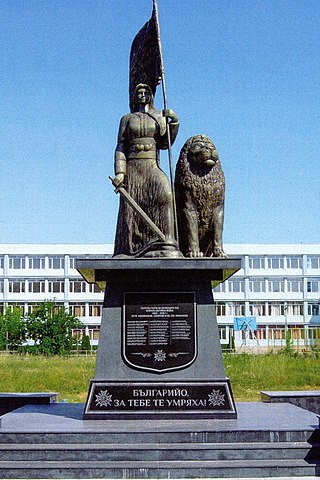
Rakovski is a town in southern Bulgaria, in the historical region of Thrace. It is located in the Plovdiv Province. The town is also the centre of the Rakovski Municipality. Rakovski was founded in 1966 with the merging of three villages — General Nikolaevo, Sekirovo and Parchevich. The new town was named after the prominent Bulgarian revolutionary Georgi Sava Rakovski.
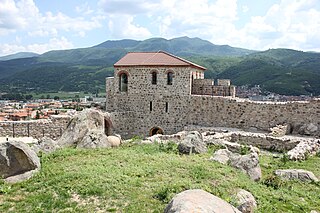
Peshtera is a town in the Rhodope Mountains, southern Bulgaria. It is located in Pazardzhik Province near the towns of Batak and Bratsigovo. The town is the third largest in the province after Pazardzhik and Velingrad and is the forty-fifth largest in Bulgaria. It is the administrative center of the municipality Peshtera. According to the 2021 census, Peshtera has a population of 15,175 inhabitants. At about 5 km to the south, along the road to Batak, is one of the most visited caves in Bulgaria — Snezhanka. Near the town is located the Peshtera Hydroelectric Power Station. The town is well known for producing the alcohol beverage mastika under the brand Peshterska.

The Plovdiv Regional Historical Museum is a historical museum in the city of Plovdiv, Bulgaria. Established in 1951, it covers the history of Plovdiv from the 15th century until today. It has three departments, each occupying a separate historic building.
100 Tourist Sites of Bulgaria is a Bulgarian national movement established in 1966 to promote tourism among Bulgaria's most significant cultural, historic, and natural landmarks.
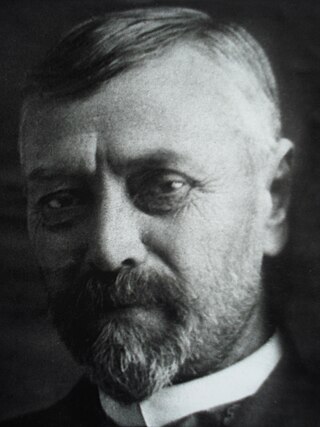
Kamen Petkov was a Bulgarian architect based in Plovdiv, Bulgaria.

The Plovdiv Regional Ethnographic Museum is a museum of ethnography in Plovdiv, Bulgaria. Since 1938, it has occupied the 1847 house of the merchant, Argir Kuyumdzhioglu, in the city's Old Town. The museum features six exhibitions, each occupying a separate room.

Hristo Gruev Danov was a Bulgarian enlightener, teacher and book publisher of the Bulgarian National Revival who is regarded as the father of organized book publishing in the Bulgarian lands and hailed as the "Bulgarian Gutenberg". After the Liberation of Bulgaria in 1878, he was also a politician and mayor of Plovdiv.

The old town in Plovdiv is an architectural and historical reserve located on three of Plovdiv's hills: Nebet Tepe, Dzhambaz Tepe and Taksim Tepe.

The Clock tower of Botevgrad is the symbol of the town and a part of 100 Tourist Sites of Bulgaria. Its clock mechanism still rings every hour with a respective number of bell rings based on the current hour. It was constructed in 1866.



























